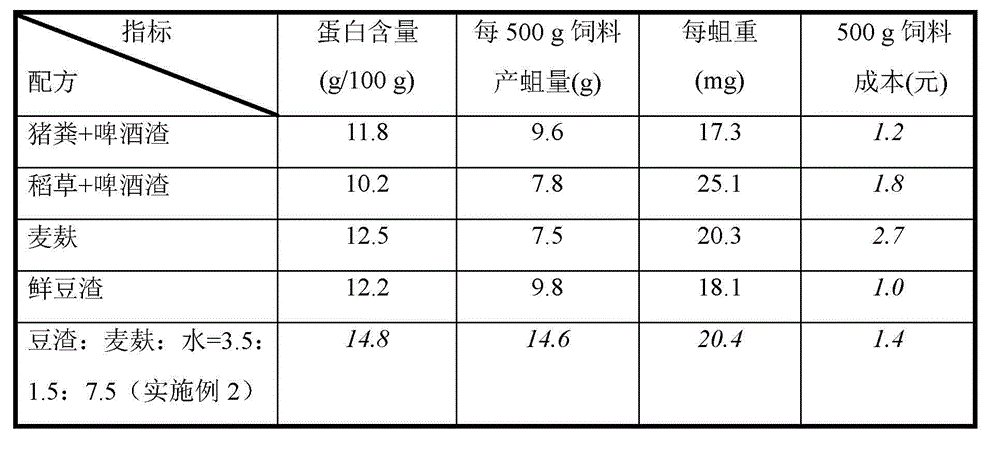Fly maggot cultivating method using bean dregs
A breeding method and technology of fly maggots, applied in the fields of application, animal feed, animal feed, etc., can solve problems such as inability to scale production, difficulty in collecting a large amount of feces, and complicated separation of fly maggots, so as to achieve improved utilization rate, short feeding cycle, The effect of low feeding cost
- Summary
- Abstract
- Description
- Claims
- Application Information
AI Technical Summary
Problems solved by technology
Method used
Image
Examples
Embodiment 1
[0045] Embodiment 1, utilize the fly maggot cultivation method that fresh bean dregs is carried out, carry out following steps successively:
[0046] 1), making fly cages:
[0047] A rectangular frame of 100 cm × 75 cm × 90 cm was made of a stainless steel tube with a diameter of 10 mm, and the bottom was a composite wood board. A high-density mosquito net (380 mesh / square inch) was placed on the frame, and a 50 cm net was installed on the front side of the cage net. Long gauze gloves for feeding and egg collection operations. Each kind of fly cage is equipped with 2 feeding trays with a diameter of 20 cm and 2 drinking basins with a sponge with a thickness of 8 mm and a diameter of 20 cm.
[0048] Above-mentioned each kind of fly cage can grow approximately 50,000~60,000 flies.
[0049] 2) Feed preparation:
[0050] The feed is obtained by mixing brown sugar and milk powder in a mass ratio of 1:1.
[0051] 3) Breeding flies:
[0052]Wash 100 g of fly pupae (individual we...
Embodiment 2
[0067] Embodiment 2, the fly maggot culture method that utilizes fresh bean dregs to carry out, changes as follows with respect to embodiment 1:
[0068] Change the "dry weight of fresh bean dregs: dry weight of wheat bran: water = 2.5: 1: 8 weight ratio" in the main ingredient of the attractant to "3: 1.5: 7.5".
[0069] The fly maggot feed was changed from "fresh bean dregs, wheat bran and water prepared in a weight ratio of 2.5:1:8 (fresh bean dregs and wheat bran were converted into dry weight)" to "fresh bean dregs, wheat bran and water were prepared by 3 : 1.5:7.5 mass ratio (fresh bean dregs and wheat bran converted to dry weight)".
[0070] All the other are with embodiment 1.
[0071] 14.6 g of fresh fly maggots can be obtained per 500 g of fly maggot feed.
[0072] After testing: the protein content of fly maggots cultured with this formula is 14.8 g / 100 g, and the proportion of oleic acid, linoleic acid, α-linolenic acid, γ-linoleic acid, EPA, and DHA in the total...
Embodiment 3
[0073] Embodiment 3, utilize the fly maggot culture method that fresh bean dregs is carried out, make following changes with respect to embodiment 1:
[0074] Change the "dry weight of fresh bean dregs: dry weight of wheat bran: water = 2.5: 1: 8 weight ratio" in the main ingredient of the attractant to "2: 1.5: 6.5".
[0075] The fly maggot feed was changed from "fresh bean dregs, wheat bran and water prepared at a weight ratio of 2.5:1:8 (fresh bean dregs and wheat bran were converted into dry weight)" to "fresh bean dregs, wheat bran and water were prepared by 2 : 1.5: 6.5 mass ratio (fresh bean dregs and wheat bran converted to dry weight)".
[0076] All the other are with embodiment 1.
[0077] Every 500 g fly maggot feed can get 9.7 g fresh fly maggot.
[0078] The protein content of fly maggots cultured with this formula is 14.5 g / 100 g, and the proportion of oleic acid, linoleic acid, α-linolenic acid, γ-linoleic acid, EPA, and DHA in the total fatty acids is 56.7%. ...
PUM
 Login to View More
Login to View More Abstract
Description
Claims
Application Information
 Login to View More
Login to View More - R&D
- Intellectual Property
- Life Sciences
- Materials
- Tech Scout
- Unparalleled Data Quality
- Higher Quality Content
- 60% Fewer Hallucinations
Browse by: Latest US Patents, China's latest patents, Technical Efficacy Thesaurus, Application Domain, Technology Topic, Popular Technical Reports.
© 2025 PatSnap. All rights reserved.Legal|Privacy policy|Modern Slavery Act Transparency Statement|Sitemap|About US| Contact US: help@patsnap.com



